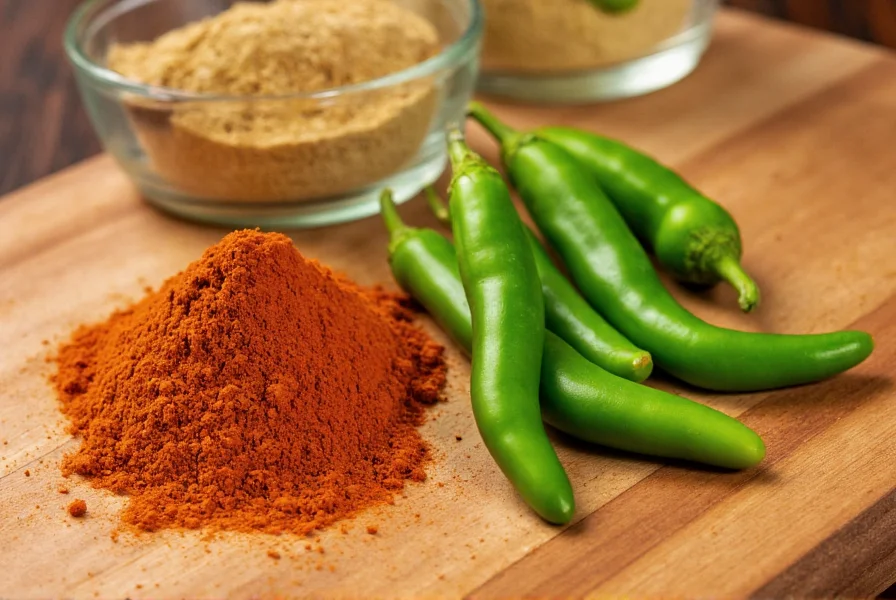Understanding chili heat levels can transform your culinary experience, especially when navigating the informal but widely used 'alarm' rating system. Two alarm chili occupies a sweet spot for many spice enthusiasts—it delivers substantial heat while remaining approachable for those building their tolerance. This comprehensive guide explores what two alarm chili truly means, how it compares to other heat measurements, and how to incorporate it effectively into your cooking.
Decoding the Alarm Rating System
The "alarm" system emerged as a consumer-friendly way to communicate chili heat levels without technical jargon. While not scientifically standardized, this informal scale has become commonplace in grocery stores across North America. The system typically breaks down as follows:
| Alarm Level | Heat Description | Scoville Range | Comparable Peppers |
|---|---|---|---|
| 1 Alarm | Mild | 500-5,000 SHU | Poblano, Bell Pepper |
| 2 Alarm | Medium | 5,000-15,000 SHU | Jalapeño, Serrano |
| 3 Alarm | Hot | 15,000-50,000 SHU | Cayenne, Tabasco |
| 4 Alarm | Extreme | 50,000+ SHU | Habanero, Ghost Pepper |
It's crucial to understand that these ranges represent general guidelines rather than precise measurements. Different manufacturers may interpret 'two alarm' differently based on their target audience and product formulation. Some brands might position their two alarm products at the lower end of medium heat, while others might push closer to hot territory.
What Makes a Chili Two Alarm Level?
Two alarm chili products achieve their characteristic heat through specific pepper varieties and careful formulation. Manufacturers typically blend:
- Jalapeño peppers (primary heat source)
- Additional peppers like serranos for complexity
- Acidic components like tomatoes or vinegar to balance heat
- Spice blends that enhance rather than mask the chili flavor
The magic of two alarm chili lies in its balance—providing enough capsaicin to create that desirable warming sensation without crossing into painful territory for most palates. Food scientists carefully calibrate these products to deliver consistent heat while maintaining rich, complex flavors that complement rather than overwhelm the dish.

Culinary Applications for Two Alarm Chili
Two alarm chili shines in recipes where you want noticeable heat that enhances rather than dominates. Professional chefs recommend using two alarm products in:
- Southwestern-style bean dishes where heat complements earthy flavors
- Tomato-based sauces that benefit from balanced spiciness
- Marinades for proteins like chicken or pork
- Chili con carne that needs substantial but not overwhelming heat
- Cornbread and other baked goods where subtle heat creates interest
When substituting two alarm chili in recipes calling for specific peppers, remember that one tablespoon of two alarm chili powder generally equals one medium jalapeño. For liquid forms, start with half the amount you'd use for fresh peppers, then adjust to taste.
Who Should Use Two Alarm Chili Products?
Two alarm chili serves as an excellent gateway for those developing their spice tolerance. It's particularly well-suited for:
- Home cooks transitioning from mild to medium heat levels
- Families wanting to introduce children to spicy foods gradually
- Individuals who enjoy flavorful heat but experience discomfort with extreme spiciness
- Cooking enthusiasts seeking complexity without overwhelming heat
Understanding your personal heat threshold is essential. If you regularly enjoy jalapeños without discomfort but find habaneros too intense, two alarm products likely align with your preferences. Culinary experts suggest building tolerance gradually—starting with one alarm products before progressing to two alarm varieties.

Comparing Heat Measurement Systems
While the alarm system provides convenient consumer guidance, understanding how it relates to scientific measurements helps make informed choices. The Scoville scale, developed in 1912 by Wilbur Scoville, measures capsaicin concentration through human taste panels or modern high-performance liquid chromatography.
Two alarm chili's position on this spectrum makes it versatile for everyday cooking. Unlike pure capsaicin extract (16,000,000 SHU), which serves industrial purposes, two alarm products deliver culinary-appropriate heat. This medium heat level activates endorphins without causing significant discomfort for most adults—a sweet spot that explains its popularity in commercial products.
Safety Considerations and Handling Tips
Even at the two alarm level, proper handling prevents discomfort. Follow these professional recommendations:
- Wear gloves when handling concentrated two alarm products
- Avoid touching your face, especially eyes, during preparation
- Start with smaller amounts and gradually increase to desired heat
- Keep dairy products like yogurt or milk nearby to neutralize excess heat
- Store products in airtight containers away from humidity
Remember that heat perception varies based on individual tolerance, accompanying ingredients, and even time of day. A dish that seems perfectly spicy at dinner might feel hotter at lunch when your palate is less accustomed to stimulation.
Developing Your Palate for Medium Heat Levels
Building tolerance to two alarm chili products follows a straightforward progression. Culinary experts recommend:
- Begin with one alarm products in familiar dishes
- After 2-3 weeks, introduce two alarm products in half-quantities
- Pair spicy foods with cooling elements like avocado or dairy
- Pay attention to how your body responds at different times of day
- Document your progress to understand personal heat thresholds
This gradual approach allows your TRPV1 receptors (which detect capsaicin) to adapt without overwhelming your system. Most people develop noticeable tolerance within 4-6 weeks of consistent, measured exposure.
FAQ
Is two alarm chili too hot for beginners?
Two alarm chili represents a medium heat level that's generally approachable for beginners who enjoy mild spice. It's significantly milder than three or four alarm products. Those completely new to spicy foods might start with one alarm products before progressing to two alarm varieties. The heat level typically compares to a medium jalapeño pepper, which most adults can handle in moderate quantities.
How does two alarm chili compare to jalapeños?
Two alarm chili products generally match the heat range of fresh jalapeño peppers (2,500-8,000 Scoville units), though some formulations may reach into the lower end of serrano territory (up to 15,000 units). The key difference is consistency—commercial two alarm products deliver reliable heat levels, while fresh jalapeños can vary significantly based on growing conditions, with some being quite mild and others surprisingly hot.
Can I substitute two alarm chili for cayenne pepper?
Yes, but with caution. Cayenne pepper typically measures 30,000-50,000 Scoville units, making it substantially hotter than most two alarm products (5,000-15,000 units). When substituting, use approximately one-third the amount of cayenne compared to two alarm chili. For precise control, start with half the recommended amount and adjust after tasting, as individual heat tolerance varies significantly.
What dishes work best with two alarm chili?
Two alarm chili excels in dishes where you want noticeable heat that enhances rather than dominates. Ideal applications include chili con carne, Southwest-style bean dishes, tomato-based sauces, meat marinades, and cornbread. It's particularly effective in recipes with complementary flavors like cumin, garlic, and smoked paprika. Avoid using it in delicate dishes like seafood or light pasta sauces where the heat might overwhelm more subtle flavors.
How can I reduce the heat if I've added too much two alarm chili?
If your dish becomes too spicy from two alarm chili, several effective remedies exist. Add dairy products like yogurt, sour cream, or milk, which contain casein that binds to capsaicin. Acidic components such as lime juice or vinegar can also help balance heat. Increasing the recipe's volume with additional non-spicy ingredients (beans, tomatoes, or broth) dilutes the heat concentration. Sugar or honey in small amounts can counteract perceived spiciness by triggering different taste receptors.











 浙公网安备
33010002000092号
浙公网安备
33010002000092号 浙B2-20120091-4
浙B2-20120091-4